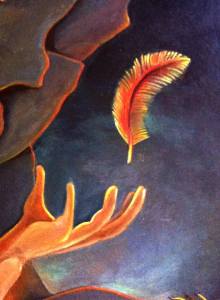Readers of high fantasy have their expectations. The story is supposed to be set in an invented – usually magic-using – world, and writers of it are expected to adhere to certain tropes. Elves, dwarves, wizards, some supernaturally powerful bad guy, dragons, magical creatures and often a protagonist who is someone special or powerful. Usually the world is so complicated and “real” for the purposes of the tale that a map is included to help the reader visualise places and background information. Some writers include glossaries and appendices to “flesh out” things without having to break the narrative with great wads of information within the text. They will have invented languages and characters with “fantasy” names like Rand al’Thor or Boromir or Arya.
And then there is Y. K. Willemse’s high fantasy series The Fledgling Account.
Willemse has done things a bit differently. She has an invented world, the Mio Pilamúr. She has a map, although it doesn’t appear in the books. She has an invented language, too. But she also has what I venture to say are radical departures from the genre. Her characters (some of them at least) use firearms as well as swords. Some have fantasy names, others are called Robert and Roger and Elizabeth. She has the supernaturally powerful bad guy, known as the Lashki Mirah, who differs from most fantasy villains by having no real agenda – he’s a total psychopath. He wouldn’t mind taking over the world (hey, don’t we all?), but he enjoys killing people anyway just because it’s fun.
All of these are good things.
The Fledgling Account is to be a seven book series. Two are out at the moment: Rafen and The Sianian Wolf. Coming this month is Servant of the King, and that will be followed by The Fourth Runi.
There is a lot to like in the series. I like the fact that fights take place using guns. I like that fact that there are no elves or dwarfs or hobbits or any of those other “required” races in high fantasy. I even like the fact there is no world map of the Mio Pilamúr* in the books: Willemse does have one she drew up and I have seen a copy of it in an email. But it’s not in the books and that’s a good thing. It means I can imagine what her world is like, I am involved in the creation process.
I also like the fact that so far Willemse has managed to avoid the two major plot lines of high fantasy: the War and the Quest (or both). The Quest is a major theme of high fantasy: the plucky hero goes off to save the world either by finding some desperately powerful McGuffin or getting rid of it. The War theme is exactly what it says. Often there is a War going on while a Quest is being fulfilled.
I don’t know whether there is a War planned for the series – there’s definitely an excuse for one, and it wouldn’t surprise me if it does come in due course. But what Willemse had produced in the first two books is a Bildungsroman. And if you don’t know what that is, it’s a literary genre (by no means restricted to high fantasy but sometimes forming part of it) that focuses on the protagonist’s psychological and moral growth from youth to adulthood.
Willemse’s protagonist, Rafen, starts out as a boy at the beginning of the series, a slave in a coal mine, and over the course of the series develops as a character, makes mistakes, rebels, loves, hates, triumphs, falls again, and ultimately (we hope) wins out over the bad guy. In other words, this series is about the main character growing up. The fact that he is fighting elemental forces of evil is a nice addition on which to hang the story of Rafen’s life. But ultimately the series is about Rafen’s clash with evil rather than the clash of good and evil in the first place.
And this is what makes Willemse’s saga such a refreshing thing. The main focus of the series is a character. Not a magic ring or a map or an invented world or some fantasy creature like an elf (be honest, how many actual elves do you know in real life?), but a raw, vulnerable, fallible human being. So far, Willemse hasn’t let the Mio Pilamúr and all that it contains overshadow the main point of the story: Rafen himself.
I guess that’s why the first book is called Rafen. Makes sense. In fact, when you think about it, all of the four (known) book titles refer to Rafen. Even the series title – The Fledgling Account – refers to him.
I’m not saying high fantasy is jaded or tired or overdone. But it’s nice to find someone willing to take it on and show the world that there is another way of doing it. It’s a brave move and, I hope, a successful one.
(Map excerpt by Y. K Willemse; Illustrations by Ruth Germon)
_________________________________________________________________
- Apparently it’s called THE Mio Pilamúr, not just Mio Pilamúr.
Russell Proctor http://www.russellproctor.com



